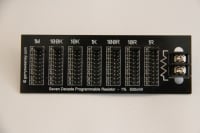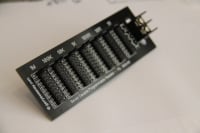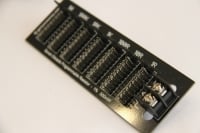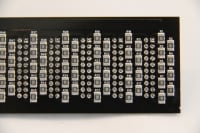I have spent a lot of time over the years prototyping electronic circuits and the amount of resistors that have ended up in the trash because they are so cheap you don’t bother to keep them tidy or organised once you take them out of their organised storage – you know the story. One potential solution to this is a programmable resistance box but the problem with these things are they are bulky and expensive and do not lend themselves well to breadboard prototyping. The cost of construction means they are typically the reserve of high-precision resistance boxes. I have a CROPICO RBB6E resistance box in my lab which I open up to have a look inside, its really well made, mostly by hand too, far too nice to abuse in prototyping….
I looked around at what is available but did not find a solution that met my own requirements so I decided to design something simple myself. I also wanted to make a simple project to get manufactured by machine which apart from other things requires reasonable volume, and I thought this project would be useful enough to others that I should get some made and make them available.
Various Pictures
Project Discussions
Project discussion thread on EEVBlog forums
Other Resources I mention in the Video
Cheap Resistance Substitution Box by @vtl on the EEVBlog
Cheap Resistance Substitution Box – Hack-a-day
If you do want one of these I have these for sale on “tindie.com”, the item listing is here:
I have also listed these on e-bay, you can search for “gerrysweeney.com” which will find the listing.
As ever, if you have any comments, suggestions or feedback, please use the form at bottom of this page
Thanks for watching
This content is published under the Attribution-Noncommercial-Share Alike 3.0 Unported license.










Really cool little project that addresses fundamental problems in prototyping!
I was excited by your thinking and, as one does, got to thinking.
What if you made each decade on a single board but with a right angled 2 pin header as a terminal at the bottom, then a small “arduino type breadbord” could be used as a back plane >- multiple resistances in a small package!
All the best Steve
Hi Steve,
Thanks for your comments, thats an interesting idea, I am not sure how useful I would find that as you would be limited to the step of that decade but I see where you are going.
Gerry
Very fresh idea. I can see it being used for an LED brightness matching rig. I’d buy a few of them right away but I dumped my PayPal account a month ago because of the bank account linking requirement. ‘Working on an alternative.
Caps decade box next? (kidding) Keep up the good work.
BTW, those current sense resistors are hard to find in the US.
Mike
Hi Mike,
Thanks for the feedback, much appreciated. I already have one of my pals using it for exactly that purpose, matching LED brightness, it’s very handy for that. Its a simple idea but people have generally warmed to it, many more than I expected have sold already.
Those current sense resistors are hard to find here in the UK too, I only found them because someone posted a comment and pointed me at the distributor in Europe that has them, but they are not cheap either, about £7 each all told.
Gerry
I’ve created a simple snap-on box for 3D-printing, you can download it at
http://www.thingiverse.com/thing:114201
Jürgen
Hi Jürgen, wow that’s really great, I am sure many people will appreciate you sharing that. I will need to get me a 3D printer now…what one did you use? Gerry
Dear Jürgen,
I tried to download the case, but it was too big to fit through the small internet wires coming into my house.
I’m just making a dumb joke, of course. That’s great that you designed the case; thank you! If anyone offers to sell these cases, I hope you’ll let us know here.
Thanks.
Got a pair. Will be using them all the time. Keep up the good work.
Your welcome, thanks for the order. Gerry
Hello Gerry,
I received my 2 programmable resistors today — thanks for such quick shipping to USA.
This design is truly an ingenious blend of functionality, simplicity and economy — it’s really great.
I know you’ve had a lot of suggestions, but if you don’t mind 2 more cents, my only input is that a low-cost enclosure might protect it and make it bit more durable on my messy bench. I wouldn’t even say that you should provide the enclosure, but I wonder if it could fit a standard plastic case similar to Dave’s MicroCurrent, in which the PCB becomes the top of the box. Well, regardless, I’m very happy with them; thank you very much!
HI John,
Thank you for the feedback, much appreciated, I am glad you like the device. I have asked a question of an injection moulder but I suspect that it will be cost prohibitive. Jurgen posted here and made a case using a 3D printer, he has made the design available (link in the comments), you can have these printed using one of the on line 3D printers if that helps.
Gerry
Hi Gerry,
No I wouldn’t suggest a custom box. I was wondering if one of those off-the-shelf black or blue plastic project boxes would be the right size. But no worry; now I’m looking forward to the capacitors!
Hi John,
When I sized the board I did look around quite hard for an appropriately proportioned standard case that I could use but I could not find anything in the end. I am still looking into options, I am interested in learning a little bit about 3D design and plastic injection moulding – then all I have to do is find a company that can create a low-cost injection mould – these things cost $1000’s to make from what I understand.
Gerry
Yes, the tooling will be quite expensive. Some people are using the 3D printer to create parts leading to soft tools for limited production runs like at this link:
http://www.3ders.org/articles/20130408-making-short-run-injection-molds-with-3d-printing.html
But it’s a bit more complex to make something like a project box; you have to make sure you can properly fill the entire mold.
Well, that could be an interesting project for you! Keep up the good work!
Hi John,
Interesting idea using a 3D printed mould, highly experimental and as you say, not likely to work for a project box. Its an interesting area to learn about, I would certainly like to have something made so I can go through the process. Thanks for your comments
Gerry
Just a quick comment
Our chinese “hobbyists” already appreciated your great , yet simple idea
[[link removed]]
Hi Alex,
Indeed, I seen this yesterday when someone pointed it out. Its nice that I came up with an idea thats worth the effort of copying 🙂 I removed the link to lower the link back traffic but if anyone wants to see a clone of my programmable resistor board you can search e-bay for item ref: 161074502921
Gerry
Hi Gerry. I tried to buy some from Tindie but New Zealand is not accepted as a destination. Mailing something to NZ must be pretty much the same as to Australia. As a Ten-Pound-Pom I must insist all the colonies be treated equally. Regards
Hi Nick, of course no problem, I just need to respond to the Tindi request to add postage for NZ but I only have mobile access until tomorrow. I will see if I can do it now. Gerry
That is really interesting, You are a very professional
blogger. I have joined your rss feed and look ahead to in the hunt for more of your magnificent post.
Also, I’ve shared your site in my social networks
Thank you very much for your comments and kind words. I love sharing information about my electronics endeavours and its always nice to get positive feedback.
Gerry
Lovely idea – well done.
For a custom case, have you thought about vacuum moulding? The lines are not as crisp as an injection moulded case, but the entry costs should be lower. My daughter got to make a small case in school for an electronics project that way and it seemed robust enough for work bench use.
Hi Kevin,
Not really given the vacuum moulding consideration, I will look into it, I wonder how much of an alternative this would be, I thought VM was suitable for thinner materials. Thanks for the suggestion
Gerry
I think you are right, the thinner end of manufacturing for sure – but a couple of minutes on e-bay found vacuum sheet up to 2mm thick.
I don’t visualise measurements well so I grabbed a few things off my desk for comparison, the case of an old usb stick 1.5mm thick – the Ferrero rocher box I keep screws in 2mm.
I think with careful choice of shape it would suit the size of enclosure you are looking at – if you can find somewhere that will let you do a test run you could probably test the theory quite cheaply.
Of course, the look is somewhat more ‘organic’ than injection moulding or 3d printing so it might not be aesthetically where you want to be.
K
Hi Kevin, yeah I am not sure it would get something acceptable. Food for thought though. Gerry
I ordered one from Tindie, as your Ebay action had finished during the weekend. In the meantime, and while I wait, my friend surprised me by printing a snap-on case for it using Juergen Gruendmayer’s model: http://www.thingiverse.com/make:49183 . Looking good!
/Pedro
Hi, can you tell me if you will have anymore of the seven decade resistors for sale on eBay soon please or is there somewhere else I can buy in the UK. Thanks
Hi Dan,
You can buy them on my tindie store here https://www.tindie.com/stores/gerrysweeney/ or on e-bay. If you are in the UK you can let me know what you want and I can send you a paypal invoice.
Gerry
An interesting chip is the AD5246 that is programmable from the circuit it’s being used in, in theory. Programmable resistors as they call them, also store the value programmed previously, so they can be used for prototyping. In practice, you’d put them on small board with header for programming signal and voltage. Essentially like a DAC but with the pull-up resistors tied instead to an external VIn pin so that you aren’t restricted to a specific internal voltage reference. Yes, it’s analog and unpolarized so you can use it anywhere that a normal resistor array and MOSFET-based switches would go.
Yeah I have seen these before, not used one but electrically they have limited application because of their reference to ground – you cant beat an actual passive resistor for prototyping 🙂 Thanks for the suggestion and comments though.
Gerry
I just discovered your blog and decade resistance box. It looks really useful. I would like to buy one. A suggestion I would like to make is to replace the jumpers with DIP switches instead. Jumpers can fall off and get lost on the floor and are a bit fiddly. I think I would get a bit frustrated repositioning the individual jumpers all the time.
Hi Simon,
There are quite a few comments on this topic and I discuss it in the video. Basically I chose jumpers for cost and reliability reasons. Cost because they are very cheap, if you do loose a jumper they are easy to replace, most people into electronics will have these laying around. Second was reliability, the problem with DIP switches, apart from the fact they are more expensive, they are not designed for large numbers of operations so will wear out if used a lot, is a tough ask to wear out a jumper pin so I made the design decision to use jumpers. Hope that makes sense.
Gerry
Just wondering, the decade resistor is programmable right…what does that exactly mean? Do I have to hook up a chip, transistor or something?
The reason why I’m asking is if I were to create say a temperature or pressure circuit with a Wheatstone Bridge and I want 2 variable resistors, one being the sensor itself and the other being an auto-compensating programmable resistor so that one doesn’t have to manually change the R value, would your design help? Would be great if you had a simple example of sorts!
Cheers,
Zack
Hi Zak,
The resistor is programmable in as much as you can dial in a specific resistance as required. You programm the value you want using simple jumpers which are laid out in decades. This is generally only useful for testing or debugging where you want to be able to dial in specific resistance values while you are working. The programmable aspect means, that unlike a potentiometer (volume control type interface) where you cannot easily know the exact resistance you are setting, with this you can set a specific resistance and “know” its that value (within the tolerance of the device its self of course).
Hope that helps
Gerry
Hello:
I have a project which is for following the changing earth’s resistance over one day and repeating the cycle continuously.
The earth [I found out] has basic resistance of 150 million Ohms and variance of about 2 M Ohms over that value – changing from sunrise max to midday min.
then sunset max and midnite minimum.
the delta R over a cycle is around 2000 Ohms her second, so can you recommend your product do use in this project? And my question is how can one use this product with the two leads only shown?
And can you recommend some designer such as fiver.com?
Regards
Wayne Eligur
Tucson, Arizona USA
Hello,
It does not sound like this is for you 🙁
Gerry
Thank you, this is now fixed.
Gerry